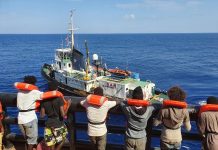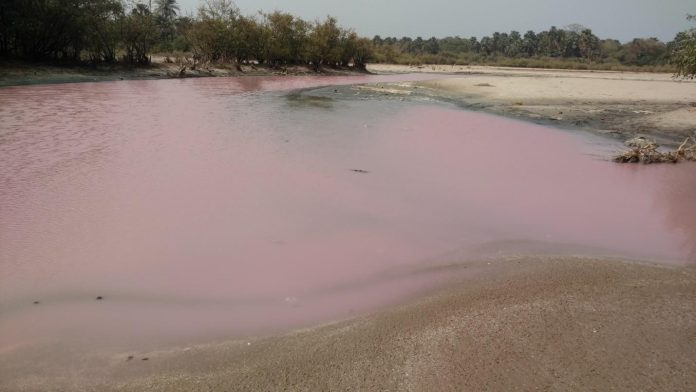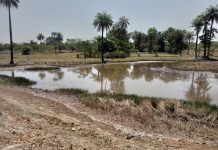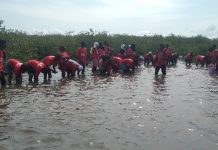By Hatab Nyang
Pollution of the Bolongfenyoto Lagoon, located behind the Golden Lead Fishmeal Factory in Gunjur, is raising serious concerns among environmentalists, residents, and eco-tourism operators, as the lagoon’s waters turn pink and emit a foul odour.
This lagoon, commonly referred to as Bolongfenyoto, is not only a vital fishing and grazing site for locals and tourists but also a sanctuary for diverse aquatic and wildlife, including crabs, tilapia, crocodiles, birds, and mangroves. Its ecological importance has also led to the establishment of conservation initiatives like the Gunjur Conservationist and Eco-Tourism Association (CETAG), a coalition of seven environmental groups dedicated to protecting endangered species, particularly green marine turtles.
Between May 26th and 30th, 2025, this reporter observed a disturbing sight at the lagoon: its shoreline was visibly discoloured—pinkish, foamy, and odorous. Notably, wastewater was observed flowing from the back gate of the Golden Lead Factory directly into the lagoon.
“This is unacceptable,” lamented Cherno Yum Jadama, a senior staff member at CETAG Turtle Village. “I’ve been working here for eight months, and I’ve never seen the lagoon water turn pink like this. Before this, birds would flock here to feed on juvenile fish like tilapia, but now they are gone. If all the fish die, the crocodiles and birds won’t have food either.”
The lagoon’s contamination has not gone unnoticed by local eco-tourism advocates. Lamin Jassey, spokesperson for Eco-Travel Gambia—a community-based non-profit—voiced deep frustration.
“Golden Lead Fishmeal Factory keeps playing the same game. This lagoon is the only breeding ground for fish in Gunjur beach, and its pollution is unacceptable,” Jassey said. “Every rainy season, we would see juvenile fish leave the lagoon and enter the ocean. Now, their habitat is being destroyed.”
Jassey also raised concerns about unauthorised plumbing infrastructure allegedly extending from the factory into the Bolongfenyoto forest. “If you’re doing your work, keep it within your premises—not in a protected area. We’ve seen sewage water with a strong odour discharging directly into the lagoon. The government is aware, but nothing is being done.”
He added, “We’ve been raising this issue for years, trying to avoid confrontation with the factory, but livelihoods are being compromised. That is irresponsible and unacceptable.”
A local restaurant worker near the lagoon, who asked not to be named, echoed similar concerns. He said the only times he had seen the lagoon turn pink were in 2017 and now in 2025—coinciding with periods of activity at the fishmeal factory.
“I’ve lived and worked here for years. Before the factory came, I never saw pink water or birds and fish dying like this,” he stated.
When approached for comment, a staff member at Golden Lead Factory identified only as Nick declined to speak. “Last time NEA came here and went around the lagoon. I’m not going to talk to you. Go to NEA,” he said.
Asked directly about the pink water and foul-smelling discharge seen coming from the factory, he reiterated: “I won’t talk. Go to NEA.”
Mr. Senghrorr, the fisheries officer at the Gunjur Beach landing site, confirmed that the National Environment Agency (NEA) and other stakeholders visited the site recently to investigate the lagoon’s pink water. “They collected water samples for testing and promised to get back to me once results are available,” he said.
He assured this reporter that once he receives updates from NEA, he will share the information.



















